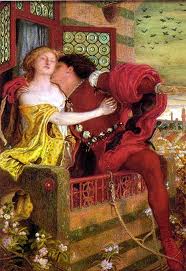~ SHAKESPEAREAN LANGAUGE ~
Language Structure
Verse – rhythm and rhyme used to help actors remember their lines, based on Greek tradition.
Prose – ordinary form of written language, all language not in verse.
Iamb – one unstressed syllable followed by a stressed syllable. (i.e. aLIKE)
Iambic Pentameter – A line of verse that consists of ten syllables with five stresses. The regular rhythm of a heartbeat; da-DUM, da-DUM, da-DUM, da-DUM, da-DUM
Blank Verse – unrhymed verse written in iambic pentameter.
Couplet – 2 rhyming lines that signify the end of a scene or thought with dramatic finality.
Caesura – a brief organic pause that exists within a line of verse.
Soliloquy – an actor’s speech which occurs when s/he is alone on the stage and which reveals his/her innermost thoughts.
Aside – an actor’s words which are not intended to be heard by the others actors present.
Punctuation
Semi colons (;) – an emotional jump or pouring out of emotion.
Colons (:) – a mental jump or demand to clarify the argument.
Periods (.) – full stop to the thought.
Literary Devices
Alliteration – the repetition of initial consonant sounds, i.e. “beautiful baby boy”
Comic Relief – the interruption of a serious work, especially a tragedy, by a short humourous episode.
Dramatic Irony – the audience knows more about a character’s situation than the character does, foreseeing an outcome contrary to the character’s expectations.
Euphemism – substitution of a mild or vague term for a harsh or blunt one, i.e. “passed away” for “dead”
Foreshadowing – a hint or clue of things to come.
Imagery – illustrative language that conjures vivid mental pictures.
Malapropism – inappropriate, muddled or mistaken use of words.
Metaphor – a comparison that suggests 2 dissimilar things are actually the same, i.e. “an icy stare”, “nerves of steel”
Oxymoron – association of 2 words or phrases which apparently contradict each other, i.e. “I need to be cruel only to be kind.”
Paradox – an opponent contradiction in a statement which on closer examination is the truth.
Pathetic fallacy – the forces of nature react in revolt against actions of man. Most often pathetic fallacy takes the form of severe thunderstorms.
Pathos – the quality in something which arouses pity, sorrow or sympathy.
Personification – a comparison in which personality or human attributes are given to lifeless things or abstractions, i.e. “The gray-eyed morn smiles on the frowning night.”
Pun – wordplay, when a word has 2 or more different meanings, ambiguity can be used for comic or serious effect.
Simile – a direct comparison of two things, introduced by like or as, i.e. “Mary’s face is as white as snow.”
Symbol – something that conventionally represents something else.
Tragedy
Antagonist – a character who opposes the protagonist in the play, i.e. Tybalt in R&J
Catastrophe – final event of a tragedy in which the hero meets his/her death.
Conflict – relationship between the antagonist and protagonist (man vs. man – external), man vs. nature (external) and man vs. self (internal). “Man” in this sense is gender neutral – referring to “human.”
Fate – the intervention of some force over which human beings have no control.
Protagonist – the hero in a tragedy or the central character in any drama, i.e. Romeo in R&J
Tragedy – drama in which the tragic hero, through a tragic flaw in his character is brought to his destruction.
Cultural Influence
Boys in women’s roles – Elizabethan actors were equal to prostitutes in their time. Women were morally banned from acting, so boys played the female roles in Shakespeare’s plays.
Aristotle’s Poetics – Shakespeare uses only one of Aristotle’s laws; Unity of Action (everything in the play must have a distinct bearing on the central theme) in Romeo & Juliet. The three unities are:
- Unity of Action: a play should have one main action that it follows, with no or few subplots.
- Unity of Place: a play should cover a single physical space and should not attempt to compress geography, nor should the stage represent more than one place.
- Unity of Time: a play should represent an action that takes approximately the same amount of time as the play; years should not pass during the hours a play takes.
According to Aristotle, a tragedy requires a tragic hero of high standing (Romeo), opposing some conflicting force, either external or internal. He should be dominated by a hamartia (tragic flaw – an excess of some character trait, i.e. pride) that leads to his downfall and, because of his status, to the downfall of others (Juliet, the Capulet and Montague families, etc.).
